Q&A Interview with ROBOT COMBAT LEAGUE Host Chris Jericho and Robot Technician Mark Setrakian
Maj Canton - February 26, 2013
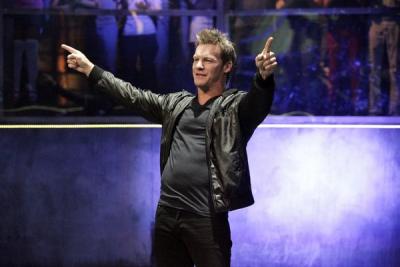
with help from: Jason Teich
A few days ago, TV Tango participated in a conference call about Syfy's ROBOT COMBAT LEAGUE, a new competition series featuring giant, state-of-the-art robots fighting in an arena. The TV show's host, WWE wrestler Chris Jericho, and robot architect and expert, Mark Setrakian, answered questions about the new series, the contestants, the production, and, of course, the giant robots crushing each other during battle.
ROBOT COMBAT LEAGUE premieres tonight, February 26, at 10pm ET on Syfy. Watch a new episode each Tuesday at 10pm ET for the entire month of March and through the end of April.
|
|
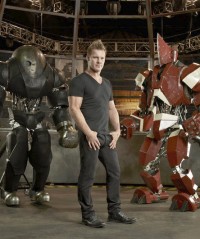 |
Question: Can you describe the show's set up? Chris Jericho: It's a nine episode arc, and it's like any other season of a show. In the first show, we find out who these people are and what's going on, and how they're learning to operate their robots. And then we have a competition to seed the contestants, the teams. The first seed goes against the twelfth seed, and so on.
Then the battles start. The battles are three 2-minute rounds. When I started watching the fights, they were so exciting, intense, and violent. There were sparks flying, fire going off, smoke, and hydraulic fluid… the lines would get severed or snapped and this fluid would shoot everywhere like arterial blood. It was like watching the opening scene of SAVING PRIVATE RYAN, where all you're seeing is explosions and amputations and decapitations. [Editor's Note: At least one robot had its foot on fire because a tech accidentally left behind an oily rag, which went up in flames as soon as sparks started flying.] |
|
Chris Jericho (continued): When the round is done, it's like a NASCAR pit crew. The tech and the jockey come down and assess the damage to the robot, and they have 30 minutes to get the robot back to the battlefield. If they can't do that, they lose a point. And the contestants have two hours to get their robot operable again, or it's a technical knockout.
If you can only fix one arm, and the other arm was dangling, you had to go back in and fight with one arm. If there isn't a knockout or TKO, then we have respected boxing judges who score the rounds and decide who the winner is.
Mark Setrakian: I was really impressed by the people judging this event. They immediately wrapped their heads around the technology and applied the rules so well. They didn't miss a thing.
Question: And it's tournament style, so the winners face the winners further down the road. Is that correct?
Mark Setrakian: Yeah, that's right. The robots are paired with a team, and that team and robot are mated for life. When a robot is damaged during a match, the team and their pit crew and I try to fix it and get it back into the match. And if they win, even if they're damaged, we have to repair that damage and get them onto the next match. And if they've lost, that's pretty much the end of it for them, because it's a single elimination contest. There's one robot per team. Chris Jericho: There are 12 different robots and 12 different teams.
Question: After the fight, do all robots get rebuilt?
Mark Setrakian: Depending on how badly they lost, there were a few robots that had to be scrapped afterwards. There just wasn't enough left to put them back together. Those were the losers. The winners are repaired, and we get them as close to factory fresh as we can, considering that they've just been in a complete wreck, like a car accident. And we get them back in the arena.
Question: What about the concept for this show will bring viewers in?
Mark Setrakian: The robots themselves are cool, but without the contestants they're nothing. It's kind of like a car without a driver. And it's that synergy of the human contestants and the robot fighters that's fascinating about the show. One of the most compelling images in the show is when you see a contestant up in the control tower operating the robots, and they're in the exosuit. You see them take a swing, and you see that robot take a swing, and you make that instant visual connection. It's like, “Wow, that person is making that thing move.”
Question: What are some of the most memorable moments we can be looking out for?
Mark Setrakian: Oh man. The fights got more and more outrageous as the series went on, as the contestants got comfortable with the robots, and they became more capable in the arena. By the second episode, you're going to see robots cut in half. I built these things, and I found them shocking.
Question: What is most crucial to keeping the robots and the series going?
Mark Setrakian: Two things: money and courage. It's hard to innovate in entertainment. How do you make a schedule and budget for something that hasn't been done before? You have to have the arena, control towers, teams, exosuits, computers, control systems, and all the stuff that it takes to make these machines fight. You have to have two of everything, because there have to be two robots. |
|
|
|
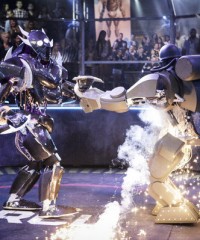 |
Question: Why did you each decide to get involved with the project? Chris Jericho: When you hear there's a show they want you to host that's about eight-foot-tall, giant fighting robots, you can't just go, “Oh, I pass.” Then to actually go and see these robots – see how fast they move, how hard they punch, how much mobility and personality each robot has – it blew my mind. On the first day, they had a robot walk towards me. If it hadn't stopped, I'd have turned and run away. That's how intimidating it was. If you get hit by one of these robots, it can knock your head off. Mark has actually created robots that can kill you. In 10 or 15 years, when these robots take over the entire human race, you're going to know that you saw them on Syfy first. |
|
Mark Setrakian: It seemed like the most audacious, challenging, completely off-the-chain project I'd ever heard of. I couldn't not do it.
Question: What have been the most rewarding and frustrating challenges you've experienced so far? Mark Setrakian: The reward was watching that first fight. The robots are under the control of the teams; they walk into the arena, and then we blow the horn, and the two robots walk towards each other and are about to start hitting. At that point, I just became a fan. The frustration was that it was hard to maintain the level of energy needed to keep the show running through the entire shooting period, which was five weeks. My team and I worked around the clock.
Question: Have both of you used the robots yourselves? Mark Setrakian: In fact, for the power-up challenge that determines the seeding of the contestants, each team had to face me in a duel to see who would rank the highest. So I got to do a little bit of a sparring with each of the teams, which you see in the first episode. I also got to drive every one of the 12 robots into the arena for the first time to introduce them to their teams. It was really fun to not only work on the robots, but to also have that maiden voyage for each one of them into the ring.
Question: It sounds and looks like it would be something cool to do, even if some of the technology is hard to understand. |
|
|
|
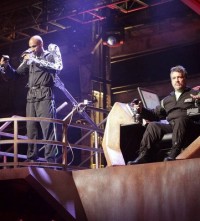 |
Question: Mark, could you talk about the design and build aspect of the robots? How they actually came to be in terms of creating specific characters and what sort of attributes they would get? Mark Setrakian: I built a prototype for this show called HADES in a shop I share. When we were approved to build the 12 robots for the series, I moved the entire project to a company called Spectral Motions, which became my fabrication shop for the project. Spectral is mostly known for doing creature effects in films, such as the HELL BOY and X-MEN movies. They have a talented staff of artists and technicians that I took full advantage of to build the robots. |
|
Mark Setrakian (continued): I basically walked into the design room, and I said, “Here's what I want this thing's head to look like.” And I drew a picture of a robot head that was shaped like an axe. The designers expanded upon that and designed a body to go along with the head. Brimstone is a robot that has this dome-shaped head, which looked like a wrecking ball. And I started to see it as being made of leather. This one was a hard sell to Syfy. They'd ask, “Leather? You mean like the gimp?” No, not like a bondage robot. A really cool robot that's durable and can withstand hard punches, like a heavy bag that hits back.
Question: Were you inspired at all by the mech warriors? Mark Setrakian: When I was growing up, I used to watch ULTRAMAN and JOHNNY SOKKO AND HIS FLYING ROBOT. Then when I was an adolescent, anime came into existence. And then George Lucas' STAR WARS, with robots that talked and had personalities. I grew up in the age of robots in entertainment. And they're so ubiquitous that when it came time to design robots for the show, it was really challenging. How do you design an original robot? It took effort to come up with robots that had distinct personalities and good designs that didn't seem derivative.
Question: Where do you see the future of robotics going? Will they have minds of their own? Mark Setrakian: All joking aside, the robots of RCL do not have minds of their own and never will. The key to RCL is the human connection. They are completely under the control of human contestants. That's what makes the show. The state of development of artificial intelligence and robotics may not be as far along as people think. I don't think we're in any real danger of the robot apocalypse any time soon.
Question: Mark, can you explain why you designed the technology so that one person controls the punches and another the foot movement? We also wanted to have it be a pairing between an athlete and a brainiac. And the operation of the upper part of the suit is this completely visceral input device. It's this exosuit. You get in and you throw a punch, and the robot throws a punch. And I tried to make that conduit from your raw emotions right to the robot as transparent as possible. The command pod, on the other hand, is more of an intellectual pursuit. You've got joysticks and an algorithm that controls the walking. And the guys and girls who were really good at making that system work understood the underlying technology. They figured out ways to work the system, to get around certain limitations. To take the functionality of the algorithm and tweak it, and use it to their advantage in the ring. So you've got two people that are using two different aspects of the robot. And it was a much richer experience to have it like that.
Question: Is there a reason that you chose specific robots for each team? Mark Setrakian: Yeah, and the technology of the robots is such that the personalities of the contestants come through the robots themselves. We started to recognize specific fighting styles that the robots had that were coming directly from the contestants.
Question: Some of your contestants had prior experience with robots, specifically Dave Shinsel. I'm wondering if he had a leg up, because of his work building robots prior to ROBOT COMBAT LEAGUE? |
|
|
|
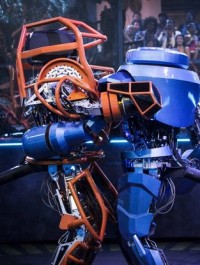 |
Question: In the movie REAL STEEL and the 1963 TWILIGHT ZONE episode with Lee Marvin, fans of futuristic robot fighting seem to be the same type of fans you would see at boxing or MMA. What is the fan base of ROBOT COMBAT LEAGUE? And how much do you think this will appeal to current fans of sports like boxing and MMA? Chris Jericho: The obvious difference in REAL STEEL or TWILIGHT ZONE is that [the stories portray] something that had been going on for a while. People were used to seeing robots fight, and it was the replacement for boxing. Since we've never seen this before, more people are going to check it out, because it's robots that are fighting. Robot fans and sci-fi fans have been waiting for something like this to happen. Then you have the boxing fans and the reality show element. Another good example of people that would be into this is the NASCAR vibe. NASCAR is a group of guys, sometimes women, who drive a piece of machinery. Some cars have different tires, and some have a different pit crew that gets it back up quicker. But it all boils down to who is driving the cars. It's about who's behind the wheel, and what kind of strategy, technique, or tactics they're using. |
|
Mark Setrakian: Exactly. This is a new form of motor sport and athletic sport rolled into one.
Question: Do you think the scenario laid out in REAL STEEL is possible? That people will want more violence and sports like boxing and MMA, but those sports will become too violent for humans to handle, so robots will stand in? Chris Jericho: I definitely see this becoming a viable form of entertainment. I think you will have standing, thinking, fighting robots. And I bet they might even put them to war at some point. The first day I came on the set, George Lucas was there. And George Lucas' daughter was one of the contestants, one of the robo-jocks. She's a MMA fighter. And I asked George, “What is it like for you to see these ideas that you had 40 years ago coming true?” And he said, “It's the way technology is moving.” |
|
|
|
